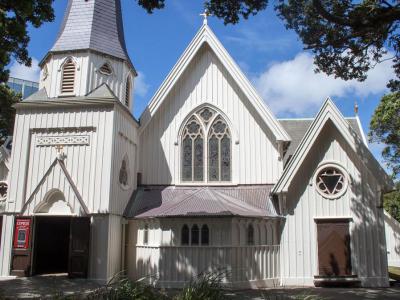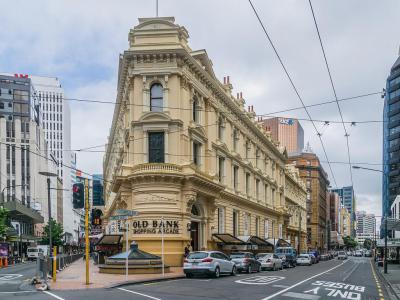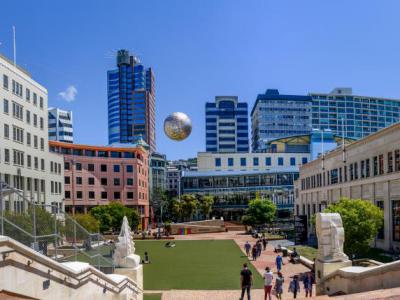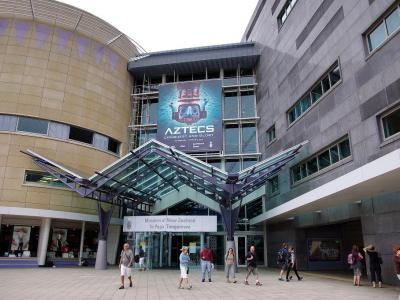Wellington Introduction Walking Tour (Self Guided), Wellington
Wellington is the capital of New Zealand and the country's second-largest city after Auckland. It also has the distinction of being the world's windiest city by average wind speed.
The city was designed by Captain William Mein Smith in 1840. He was the first Surveyor General for Edward Wakefield's New Zealand Company. The name comes from Arthur Wellesley, the first Duke of Wellington. In the nation's native Maori language, Wellington is referred to as Te Whanganui-a-Tara, which translates to "the great harbor of Tara." This is due to the Maori legend that Tara, the son of Chief Whatonga, settled in this area around 1000 CE.
Wellington is not the official capital of the country. In fact, no official capital has ever been established for New Zealand. However, convention has placed Wellington as the capital city due to the fact that the country's government, parliament and supreme court are all based here.
Much of the history of Wellington can be seen within the city's center, near the harbor. Those visiting Wellington will find the old Parliament Buildings, which includes the iconic Beehive. Nearby is Old St. Paul's, a church that shows off the Gothic Revival architecture that was popular in the city during the mid-19th century.
Even more history is found at the Museum of New Zealand Te Papa Tongarewa. This museum displays the history of the city and the country as it has unfolded over time. There are also displays of fine art and interactive exhibits.
Visitors who love to shop will find many choices along Wellington's popular shopping, dining and entertainment areas. Lambton Quay, Willis Street, Courtenay Place and Cuba Street are all well known for their long histories as shopping areas in the city. An exploration of these streets takes visitors back in time while allowing them to find souvenirs to take back home.
Take this self-guided walking tour to explore the most notable sights of the beautiful city of Wellington, New Zealand.
The city was designed by Captain William Mein Smith in 1840. He was the first Surveyor General for Edward Wakefield's New Zealand Company. The name comes from Arthur Wellesley, the first Duke of Wellington. In the nation's native Maori language, Wellington is referred to as Te Whanganui-a-Tara, which translates to "the great harbor of Tara." This is due to the Maori legend that Tara, the son of Chief Whatonga, settled in this area around 1000 CE.
Wellington is not the official capital of the country. In fact, no official capital has ever been established for New Zealand. However, convention has placed Wellington as the capital city due to the fact that the country's government, parliament and supreme court are all based here.
Much of the history of Wellington can be seen within the city's center, near the harbor. Those visiting Wellington will find the old Parliament Buildings, which includes the iconic Beehive. Nearby is Old St. Paul's, a church that shows off the Gothic Revival architecture that was popular in the city during the mid-19th century.
Even more history is found at the Museum of New Zealand Te Papa Tongarewa. This museum displays the history of the city and the country as it has unfolded over time. There are also displays of fine art and interactive exhibits.
Visitors who love to shop will find many choices along Wellington's popular shopping, dining and entertainment areas. Lambton Quay, Willis Street, Courtenay Place and Cuba Street are all well known for their long histories as shopping areas in the city. An exploration of these streets takes visitors back in time while allowing them to find souvenirs to take back home.
Take this self-guided walking tour to explore the most notable sights of the beautiful city of Wellington, New Zealand.
How it works: Download the app "GPSmyCity: Walks in 1K+ Cities" from Apple App Store or Google Play Store to your mobile phone or tablet. The app turns your mobile device into a personal tour guide and its built-in GPS navigation functions guide you from one tour stop to next. The app works offline, so no data plan is needed when traveling abroad.
Wellington Introduction Walking Tour Map
Guide Name: Wellington Introduction Walking Tour
Guide Location: New Zealand » Wellington (See other walking tours in Wellington)
Guide Type: Self-guided Walking Tour (Sightseeing)
# of Attractions: 8
Tour Duration: 2 Hour(s)
Travel Distance: 3.6 Km or 2.2 Miles
Author: australia
Sight(s) Featured in This Guide:
Guide Location: New Zealand » Wellington (See other walking tours in Wellington)
Guide Type: Self-guided Walking Tour (Sightseeing)
# of Attractions: 8
Tour Duration: 2 Hour(s)
Travel Distance: 3.6 Km or 2.2 Miles
Author: australia
Sight(s) Featured in This Guide:
- Parliament Buildings
- Old St. Paul's
- Lambton Quay
- Willis Street
- Civic Square
- Museum of New Zealand Te Papa Tongarewa
- Courtenay Place
- Cuba Street
1) Parliament Buildings (must see)
New Zealand Parliament Buildings are the houses of the New Zealand government. There are four different buildings on the site, each built in different times and for different purposes.
The first parliament building was the Parliamentary Library, completed in 1899. It was designed in the Gothic Revival architectural style. A massive fire burned most of the parliament buildings in 1907. Only the library survived thanks to an iron fire-door and masonry construction.
The second building was the Parliament House, finished in 1922. It was designed in the Edwardian neoclassical architectural style by architect John Campbell. It contains the debating chamber, the speaker's office, committee rooms and the visitors' center.
The third building is technically a wing rather than a freestanding structure. This is the Beehive, completed in 1977. It was designed by Sir Basil Spence to resemble a beehive with its circular, tapered shape. The Beehive holds a number of parliamentary offices. There is also a restaurant on the third floor.
The most recent addition to the New Zealand Parliament Buildings is Bowen House, which was added to the site in 1991. This is home to the MP's offices and support staff.
The first parliament building was the Parliamentary Library, completed in 1899. It was designed in the Gothic Revival architectural style. A massive fire burned most of the parliament buildings in 1907. Only the library survived thanks to an iron fire-door and masonry construction.
The second building was the Parliament House, finished in 1922. It was designed in the Edwardian neoclassical architectural style by architect John Campbell. It contains the debating chamber, the speaker's office, committee rooms and the visitors' center.
The third building is technically a wing rather than a freestanding structure. This is the Beehive, completed in 1977. It was designed by Sir Basil Spence to resemble a beehive with its circular, tapered shape. The Beehive holds a number of parliamentary offices. There is also a restaurant on the third floor.
The most recent addition to the New Zealand Parliament Buildings is Bowen House, which was added to the site in 1991. This is home to the MP's offices and support staff.
2) Old St. Paul's (must see)
Old Saint Paul's is an Anglican church. The church was completed in 1866 in the Gothic Revival architectural style. The architect was Reverend Frederick Thatcher, the vicar of Saint Paul's in Thorndon.
A south transept, designed by Christian Julius Toxward, was added in 1868 to protect the church from high winds. He also designed a north transept and an extension of the north aisle in 1874 and a choir vestry in 1882.
The Diocese moved to the new Saint Paul's Cathedral in 1964. The New Zealand Government purchased Old Saint Paul's in 1967 and restored it in order to avoid demolition.
The church now displays flags in the nave that represent the Royal Navy, the New Zealand Merchant Navy and the United States Marine Corps. The interior of Old Saint Paul's has memorial plaques, specifically for those who died in World War I.
The church is now a historical site and an event venue managed by Heritage New Zealand Pouhere Taonga.
A south transept, designed by Christian Julius Toxward, was added in 1868 to protect the church from high winds. He also designed a north transept and an extension of the north aisle in 1874 and a choir vestry in 1882.
The Diocese moved to the new Saint Paul's Cathedral in 1964. The New Zealand Government purchased Old Saint Paul's in 1967 and restored it in order to avoid demolition.
The church now displays flags in the nave that represent the Royal Navy, the New Zealand Merchant Navy and the United States Marine Corps. The interior of Old Saint Paul's has memorial plaques, specifically for those who died in World War I.
The church is now a historical site and an event venue managed by Heritage New Zealand Pouhere Taonga.
3) Lambton Quay
Lambton Quay was the site of the original European settlement in New Zealand in 1840. It was once known as The Beach and is the heart of the central business district. Lambton Quay runs north and south from Thorndon Quay to Willis Street. Along with Willis Street and Courtenay Place, Lambton Quay makes up the Golden Mile.
Lambton Quay was once the high-water line of the foreshore. However, the 1855 Wairarapa earthquake caused land uplift that pushed Lambton Quay about 250 meters (approximately 273 yards) away from the shore.
Lambton Quay is one of the most traveled streets in Wellington. It is estimated that about 70,000 people pass through Lambton Quay every day. It is a major commercial and administrative area that is especially interesting to tourists. There are a number of sights worth visiting along Lambton Quay including the Wellington Cenotaph War Memorial, the Cable Car Museum and Funicular, the New Zealand Parliament Buildings and the Old Government Buildings, among others.
The street gets its name from John Lambton, 1st Earl of Durham. Lambton was the first chairman of the New Zealand Company, a company formed in United Kingdom in the first half of the 19th century on a business model focused on the systematic colonization of New Zealand.
Lambton Quay was once the high-water line of the foreshore. However, the 1855 Wairarapa earthquake caused land uplift that pushed Lambton Quay about 250 meters (approximately 273 yards) away from the shore.
Lambton Quay is one of the most traveled streets in Wellington. It is estimated that about 70,000 people pass through Lambton Quay every day. It is a major commercial and administrative area that is especially interesting to tourists. There are a number of sights worth visiting along Lambton Quay including the Wellington Cenotaph War Memorial, the Cable Car Museum and Funicular, the New Zealand Parliament Buildings and the Old Government Buildings, among others.
The street gets its name from John Lambton, 1st Earl of Durham. Lambton was the first chairman of the New Zealand Company, a company formed in United Kingdom in the first half of the 19th century on a business model focused on the systematic colonization of New Zealand.
4) Willis Street
Willis Street is one of Wellington's most prominent streets. It is one of the streets that forms the Golden Mile, along with Lambton Quay and Courtenay Place. This is the spot where much of Wellington's shopping and entertainment is located.
Willis Street runs from Brooklyn Road and Nairn Street to Lambton Quay, Willeston Street and Customhouse Quay. It is considered one of the four quarters of the downtown area of Wellington.
There are a number of notable buildings and sites along Willis Street. The Aon Centre and the Majestic Centre are the two tallest buildings in the city. Other spots of interest include Saint John's Church, the Henry Pollen House, Meanwhile Art Gallery, Bird Box park, Saint Peter's Anglican Church and the Appraisal House.
Shoppers are practically guaranteed to enjoy their time on Willis Street. The street is lined with numerous stores of all shapes and sizes. Shoe stores, supermarkets, clothing boutiques, second-hands shops and cosmetics stores are just some of the shops visitors will find. There are also numerous restaurants and coffee shops on Willis Street.
Willis Street runs from Brooklyn Road and Nairn Street to Lambton Quay, Willeston Street and Customhouse Quay. It is considered one of the four quarters of the downtown area of Wellington.
There are a number of notable buildings and sites along Willis Street. The Aon Centre and the Majestic Centre are the two tallest buildings in the city. Other spots of interest include Saint John's Church, the Henry Pollen House, Meanwhile Art Gallery, Bird Box park, Saint Peter's Anglican Church and the Appraisal House.
Shoppers are practically guaranteed to enjoy their time on Willis Street. The street is lined with numerous stores of all shapes and sizes. Shoe stores, supermarkets, clothing boutiques, second-hands shops and cosmetics stores are just some of the shops visitors will find. There are also numerous restaurants and coffee shops on Willis Street.
5) Civic Square
Civic Square, more formally known as Te Ngakau Civic Square, is a public square between the central business district and the Te Aro entertainment district. The square was completed in 1992.
Originally, Civic Square was named Wellington Civic Square. It was renamed to Te Ngakau Civic Square in 2018 as part of the City Council's Maori policy. Te Ngakau means "the heart." The new name was gifted to the city by the indigenous Maori people.
The square is surrounded by a number of administrative buildings like the Wellington Town Hall, the Michael Fowler Centre, the Central Library and the City Gallery. The Whairepo Lagoon is accessible from the Civic Square via the City-to-Sea bridge.
The square has a grassy lawn, a terracotta brick walkway and a tiled area that is actually the roof of the underground library car park. The square is a popular spot for outdoor lunches, relaxation, exercise and public events.
Originally, Civic Square was named Wellington Civic Square. It was renamed to Te Ngakau Civic Square in 2018 as part of the City Council's Maori policy. Te Ngakau means "the heart." The new name was gifted to the city by the indigenous Maori people.
The square is surrounded by a number of administrative buildings like the Wellington Town Hall, the Michael Fowler Centre, the Central Library and the City Gallery. The Whairepo Lagoon is accessible from the Civic Square via the City-to-Sea bridge.
The square has a grassy lawn, a terracotta brick walkway and a tiled area that is actually the roof of the underground library car park. The square is a popular spot for outdoor lunches, relaxation, exercise and public events.
6) Museum of New Zealand Te Papa Tongarewa (must see)
Te Papa Tongarewa, the Museum of New Zealand, stands as a prominent national institution and ranks among the world's most frequented museums. Established in 1992 and revamped in 1998 following the amalgamation of the National Museum of New Zealand and the National Art Gallery, it was designed by Jasmax Architects.
Previously recognized as the Dominion Museum and National Art Gallery, its origins trace back to the Colonial Museum founded by James Hector in 1865. Initially housing scientific collections, prints, paintings, curiosities, and antiques, it shifted focus towards Fine Arts upon the construction of the new Dominion Museum building.
Commonly referred to as Te Papa (Māori for 'the treasure box'), it welcomes approximately 1.5 million visitors annually. Te Papa's primary objective lies in the exploration and presentation of New Zealand's cultural and historical identity, as reflected in its name, which means "container of treasured things and people that spring from mother Earth here in New Zealand."
Spanning six floors, the museum integrates native flora and artificial caves into its landscape. Onsite amenities include cafes and gift shops. Its diverse exhibits encompass the History Collection, the Elgar Collection, as well as cultural artifacts, interactive displays, and items highlighting Maori culture and New Zealand's history.
The History Collection showcases textiles, stamps, fossils, and archaeozoological specimens, including the world's largest colossal squid, weighing over 1,000 pounds and measuring 14 feet long. Meanwhile, the Elgar Collection features English and French furniture and paintings.
Previously recognized as the Dominion Museum and National Art Gallery, its origins trace back to the Colonial Museum founded by James Hector in 1865. Initially housing scientific collections, prints, paintings, curiosities, and antiques, it shifted focus towards Fine Arts upon the construction of the new Dominion Museum building.
Commonly referred to as Te Papa (Māori for 'the treasure box'), it welcomes approximately 1.5 million visitors annually. Te Papa's primary objective lies in the exploration and presentation of New Zealand's cultural and historical identity, as reflected in its name, which means "container of treasured things and people that spring from mother Earth here in New Zealand."
Spanning six floors, the museum integrates native flora and artificial caves into its landscape. Onsite amenities include cafes and gift shops. Its diverse exhibits encompass the History Collection, the Elgar Collection, as well as cultural artifacts, interactive displays, and items highlighting Maori culture and New Zealand's history.
The History Collection showcases textiles, stamps, fossils, and archaeozoological specimens, including the world's largest colossal squid, weighing over 1,000 pounds and measuring 14 feet long. Meanwhile, the Elgar Collection features English and French furniture and paintings.
7) Courtenay Place
Courtenay Place is an east-to-west street in Wellington. It is the main street of the Courtenay Quarter running from Cambridge Terrace to Taranaki Street. Courtenay Place is known for being an excellent spot to find restaurants, nightlife and entertainment. Buskers are regularly found on the street as well.
The first building erected at Courtenay Place was a butcher shop with three stories, a cellar and stables. It was erected in 1900 and designed by T.S. Lambert. It is now a heritage listed building that holds a restaurant and bar.
Courtenay Place has a strong focus on the arts. The New Zealand International Arts Festival is held on this street. It was also home to New Zealand's first professional theatre, Downstage Theatre. All three films in the Lord of the Rings trilogy held their world premiere at the Embassy Theatre on Courtenay Place.
Shopping is a popular pastime on Courtenay Place. Reading Courtenay Central Complex is a development that offers numerous shopping opportunities along with restaurants and a 10-screen cinema. It received the 2003 Property Council NZ Entertainment Excellence Award.
The first building erected at Courtenay Place was a butcher shop with three stories, a cellar and stables. It was erected in 1900 and designed by T.S. Lambert. It is now a heritage listed building that holds a restaurant and bar.
Courtenay Place has a strong focus on the arts. The New Zealand International Arts Festival is held on this street. It was also home to New Zealand's first professional theatre, Downstage Theatre. All three films in the Lord of the Rings trilogy held their world premiere at the Embassy Theatre on Courtenay Place.
Shopping is a popular pastime on Courtenay Place. Reading Courtenay Central Complex is a development that offers numerous shopping opportunities along with restaurants and a 10-screen cinema. It received the 2003 Property Council NZ Entertainment Excellence Award.
8) Cuba Street (must see)
Cuba Street is a major city street and one of the best known streets in Wellington. It is often thought of as the cultural center of the city. The street and its surrounding area offer numerous music venues, bookshops, record shops, restaurants and cafes.
Cuba street runs from Te Ngakau Civic Square to Webb Street. It is fully pedestrian between Ghuznee and Manners Streets. Cuba Street was originally a street full of basic homes that evolved over time. The historic buildings, built in the 19th and 20th centuries, are in Edwardian and Art Deco styles.
The street was developed when the land was colonized. It was named for the settler ship, the Cuba, which arrived at the harbor in 1840. It was named by Captain William Mein Smith, the first Surveyor General.
In the 1970s and 1980s, a portion of Cuba Street was in the city's red-light district. Peep shows, strip clubs and gay bars populated the street. There were also numerous street prostitutes in the area. New Zealand's most famous drag queen and activist, Carmen Rupe, ran a coffee lounge in the red light district. Her likeness is now on pedestrian light signals in the four intersections along Cuba Street.
Cuba Street was registered as a historic area in 1995. It has over 40 buildings that are deemed to be historically significant. Two of these buildings include the Bank of New Zealand Building and the National Bank Building.
Today, you will find shopping, dining and plenty of art on Cuba Street. You will also find public art, like the Bucket Fountain, which is located on Cuba Street's Commonwealth Walkway.
Cuba street runs from Te Ngakau Civic Square to Webb Street. It is fully pedestrian between Ghuznee and Manners Streets. Cuba Street was originally a street full of basic homes that evolved over time. The historic buildings, built in the 19th and 20th centuries, are in Edwardian and Art Deco styles.
The street was developed when the land was colonized. It was named for the settler ship, the Cuba, which arrived at the harbor in 1840. It was named by Captain William Mein Smith, the first Surveyor General.
In the 1970s and 1980s, a portion of Cuba Street was in the city's red-light district. Peep shows, strip clubs and gay bars populated the street. There were also numerous street prostitutes in the area. New Zealand's most famous drag queen and activist, Carmen Rupe, ran a coffee lounge in the red light district. Her likeness is now on pedestrian light signals in the four intersections along Cuba Street.
Cuba Street was registered as a historic area in 1995. It has over 40 buildings that are deemed to be historically significant. Two of these buildings include the Bank of New Zealand Building and the National Bank Building.
Today, you will find shopping, dining and plenty of art on Cuba Street. You will also find public art, like the Bucket Fountain, which is located on Cuba Street's Commonwealth Walkway.
Walking Tours in Wellington, New Zealand
Create Your Own Walk in Wellington
Creating your own self-guided walk in Wellington is easy and fun. Choose the city attractions that you want to see and a walk route map will be created just for you. You can even set your hotel as the start point of the walk.
Historical Buildings Walking Tour
The first immigrants to New Zealand brought along their sense of style. Most of the country's first settlers, if not all of them, were Britishers; the capital city was no exception. The latter fact is duly reflected in Wellington's historical architecture. These buildings offer a glimpse into the city's past and add a great deal of charm to the cityscape. Let's take a quick... view more
Tour Duration: 2 Hour(s)
Travel Distance: 3.5 Km or 2.2 Miles
Tour Duration: 2 Hour(s)
Travel Distance: 3.5 Km or 2.2 Miles
The Most Popular Cities
/ view all












